As I recently wrote in my post about Prachovské Skály, I went there twice. In July 2010, then in July 2016. In July 2010, I was still just using a Point and Shoot camera, pretty much just “snapping pictures as I went along”, with not much photographic sense or education other than “I read the manual” and “read somewhere about the rule of thirds”. I did already like taking pictures, though, and in May 2011, when the P&S camera died, that’s when I decided to step up my game, invested in a DSLR, and started to get more serious about learning “proper” photography. I even purchased *a book* about it (that’s how committed I was. Understanding Exposure, by Peterson, btw, excellent book). I learned about locking exposure and recomposing, about exposing for the sky, about the exposure triangle, about the RAW format and image postprocessing. My two visits, six years apart, under the exact same meteorological conditions (clear blue sky with a couple of clouds and blazing hot july sun), provided the perfect opportunity for a little before/after comparison, especially since I took a few shots from the exact same spots.
Comme je l’écrivais dans mon billet sur les Prachovské Skály, j’y suis allé deux vois. En juillet 2010, puis en juillet 2016. En juillet 2010, j’utilisais encore un appareil compact, juste “prenant des photos sur le chemin”, sans vraiment avoir l’œil ou une éducation photographique, autre que “j’ai lu le manuel” et “j’ai lu un truc quelque part sur la règle des tiers”. J’aimais déjà prendre des photos, par contre, et en mai 2011, quand le compact est mort, c’est là que j’ai décidé de monter d’un cran, ai investi dans un Reflex, et ai commencé à être plus appliqué dans l’apprentissage de la “vraie” photographie. J’ai même acheté *un livre* dessus (c’est dire à quel point j’étais sérieux. Understanding Exposure, de Peterson, au passage, un excellent bouquin). J’ai appris à verrouiller l’exposition et recomposer une image, à exposer pour le ciel, ce qu’est le triangle d’exposition, le format RAW et le traitement d’image. Mes deux visites, à six ans d’écart, sous les mêmes conditions météo (ciel bleu avec quelques nuages et soleil de juillet qui cogne), furent une occasion rêvée pour une petite comparaison avant/après, surtout vu que j’ai au final pris plusieurs photos des même points de vues.
The Vyhlídka Prof. Hakena
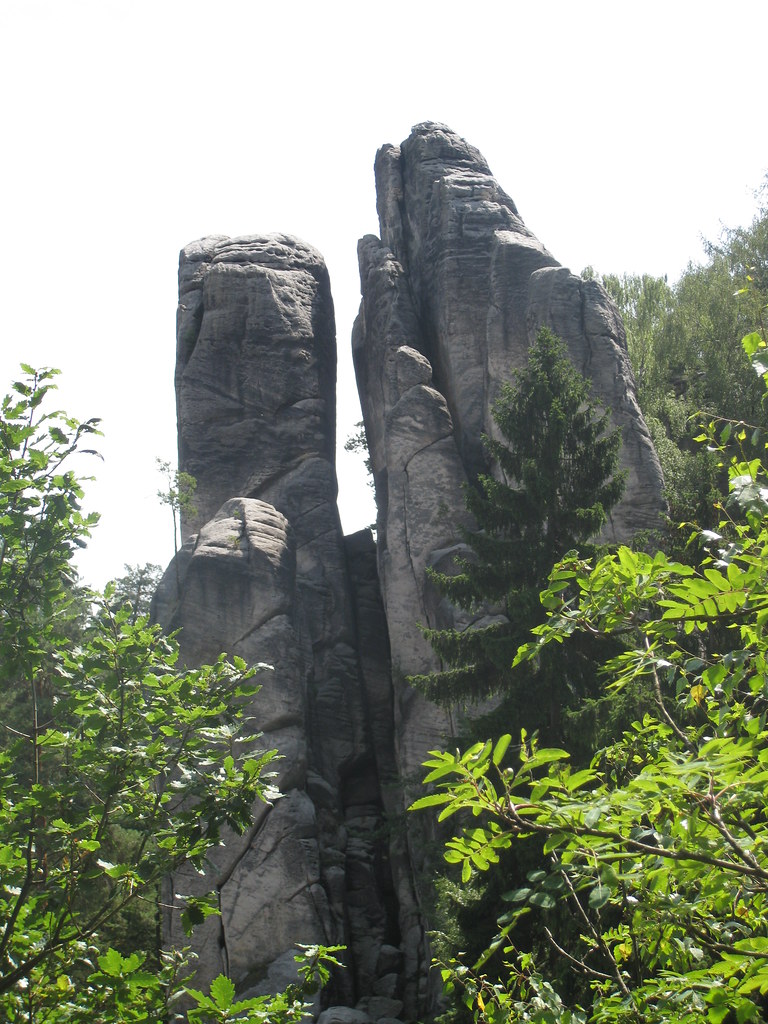
As you can see, I had no idea what I was doing, the biggest problem being the burnt sky, obviously. Coming home I’d be disappointed because I had no idea why, and how to fix it (protip: you can’t. when it’s burnt, it’s burnt). What I learned since then was that the sky was blown out because the dynamic range in the picture was too high. The camera tried to make the tower, which took most of the frame, look “ok” (as in 18% grey ok), which caused the bright sky to be blown out.
Comme vous pouvez le constater, je n’avais aucune idée de ce que je faisais, le problème principal étant le ciel cramé, bien sûr. En rentrant j’étais déçu parce que je ne savais ni pourquoi, ni comment arranger la photo (astuce d’expert: on peut pas. Quand c’est cramé, c’est cramé). Ce que j’ai appris depuis c’était que le ciel était cramé parce que la gamme dynamique sur la photo était trop élevée. L’appareil avait essayé de rendre la tour, qui prend la plupart du cadre, “ok” (genre 18% de gris “ok”), ce qui a superexposé le ciel.
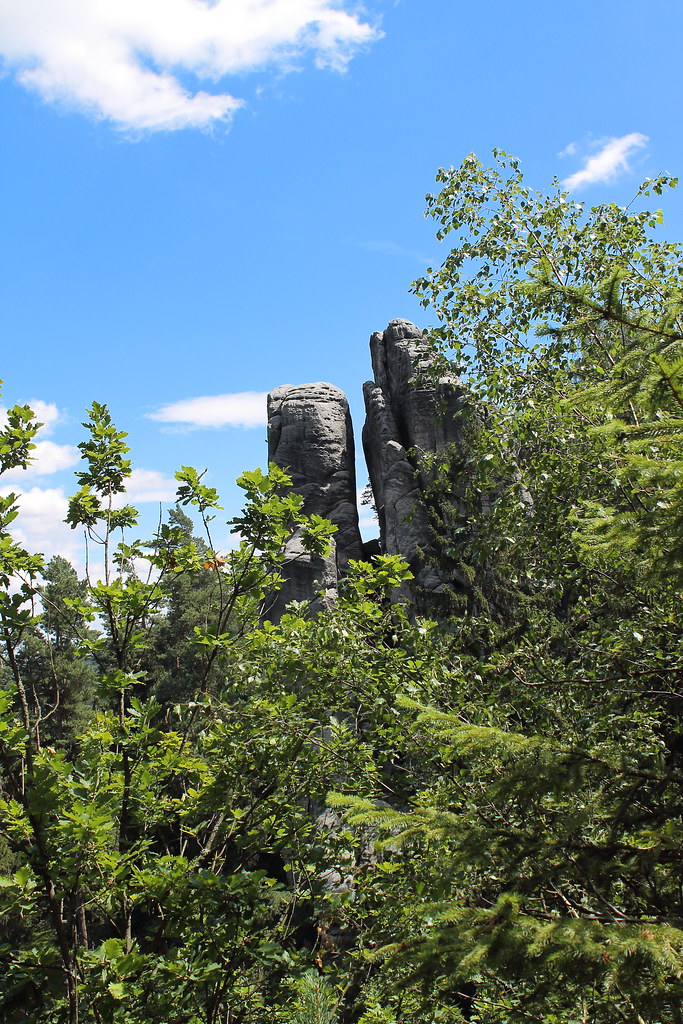
In the second shot, I tried to move back in order to get a bigger view of the area, so that the towers do not take all the frame, and include a bigger portion of sky and vegetation. Also, I used “exposure lock” in order to get the exposure value I would need in order to get a “blue sky” (by pointing the camera at the sky, let it meter, and lock that exposure value with the button, then frame and refocus). Loading the RAW file in Digital Photo Professional, the sky was still almost blown out, but the colors could be recovered.
Dans le deuxième cliché, j’ai tenté de reculer pour avoir une vue plus large de la scène, afin que les tours ne prennent pas tout le cadre, et inclure une plus grande part de ciel et de verdure. Aussi, j’ai utilisé la fonction “verrouillage d’exposition” de l’appareil pour obtenir les réglages qui donneraient un “ciel bleu” (en pointant l’appareil sur le ciel, le laissant mesurer l’exposition, et verrouiller ça avec le bouton, puis recadrer et refaire la mise au point). En chargeant le fichier RAW dans Digital Photo Professional, le ciel était encore presque surexposé, mais les couleurs étaient récupérables.
The Cisařská Chodba

Again with the blown out sky, obviously. I liked how the branches around kind of looked like a natural frame, so I wanted to incorporate the trees around to make it look like a “window”. But that branch coming down in the middle ends up looking like it comes out of nowhere, pretty much.
Encore un ciel surexposé, évidemment. J’aimais que les branches autour forment un genre de cadre naturel, donc je voulais les incorporer dans l’image pour donne l’impression d’une fenêtre naturelle. Mais cette branche qui descend en plein milieu a au final l’air de sortir de n’importe où en fait.
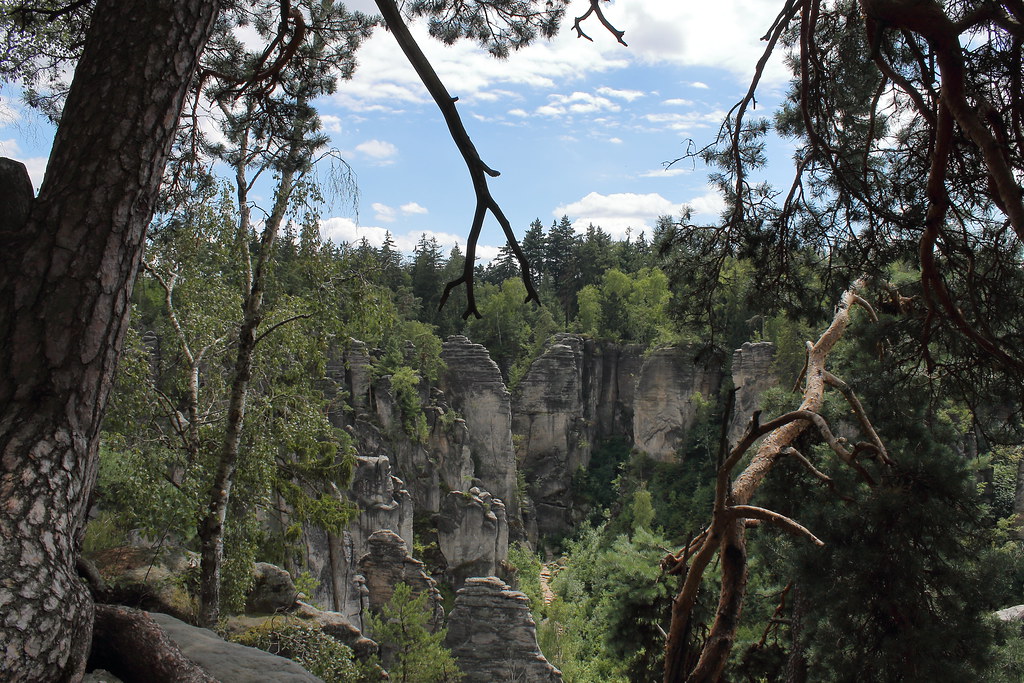
In the second shot, I applied the same principles as before in order to avoid the blown out sky, and you can see from the exposure settings, a much smaller aperture value, for a slightly longer shutter speed. In terms of framing, it made more sense to try and have a wider frame, that would incorporate the bigger tree trunk from which the branch hangs out in the center. It’s still not possible to see the junction, but it’s better, and one can actually guess where that branch is coming from. Now, I could probably have removed it with some GIMP magic, but it’s part of the scenery. It’s what stands in your face when you actually stand on this spot and I kinda like it that way.
Dans le second cliché, j’ai réappliqué les principes ci-dessus pour éviter le ciel cramé, et vous pouvez voir sur les réglages d’exposition, une ouverture bien plus petite, pour un temps d’exposition à peine plus long. Pour ce qui est du cadrage, un cadre un peu plus large semblait plus naturel, pour inclure le tronc duquel la branche du milieu descend. On ne voit toujours pas l’embranchement, mais c’est mieux, et on peut deviner d’où vient la branche maintenant. Maintenant, j’aurais sûrement pu la retirer avec un tour de magie sous GIMP, mais ça fait partie du paysage. C’est ce qui vous saute au nez quand vous vous trouvez à cet endroit, et je l’aime bien comme ça.
The Cisařská Chodba (again)
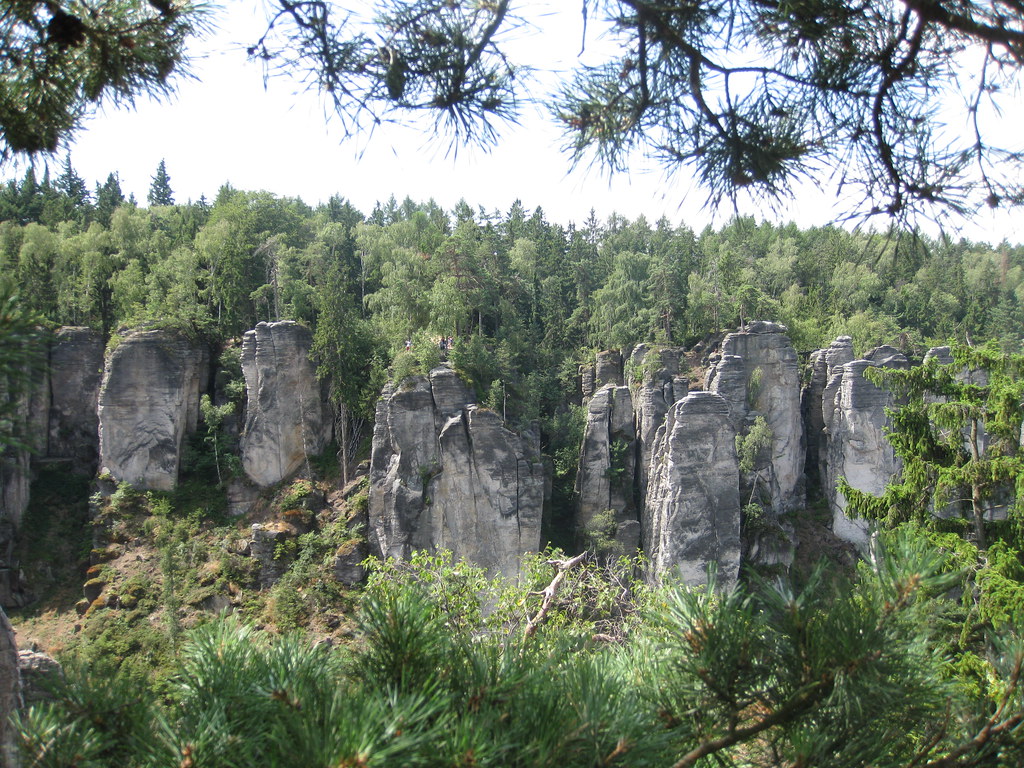
This camera must have had a thing for blown out skies :p. Guess that’s why I delayed writing a post about the place for so long, my pictures of it felt so bad… anyways, again I tried to incorporate some of the foreground vegetation to make a frame around the shot. But the end result, with that aperture, is a kinda mushy and not really pleasing picture, I find. Especially since the vastness of the gorge would have warranted a more “open” framing, to try and convey the size of the scenery.
Cet appareil devait avoir un goût pour les ciels surexposés :p. Sûrement pour ça que je n’avais jamais écrit à propos de l’endroit, mes photos de l’endroit me semblaient si nulles… enfin bon, une fois de plus j’ai tenté d’inclure la végétation autour pour faire un cadre autour de l’image. Mais le résultat final, avec cette ouverture, ne ressemble un peu à rien et n’est pas très agréable à l’œil, je trouve. Surtout que la grande étendue qui s’étale sous les yeux aurait invité un cadrage plus “ouvert”, pour tenter de donner une impression de grandeur du paysage.
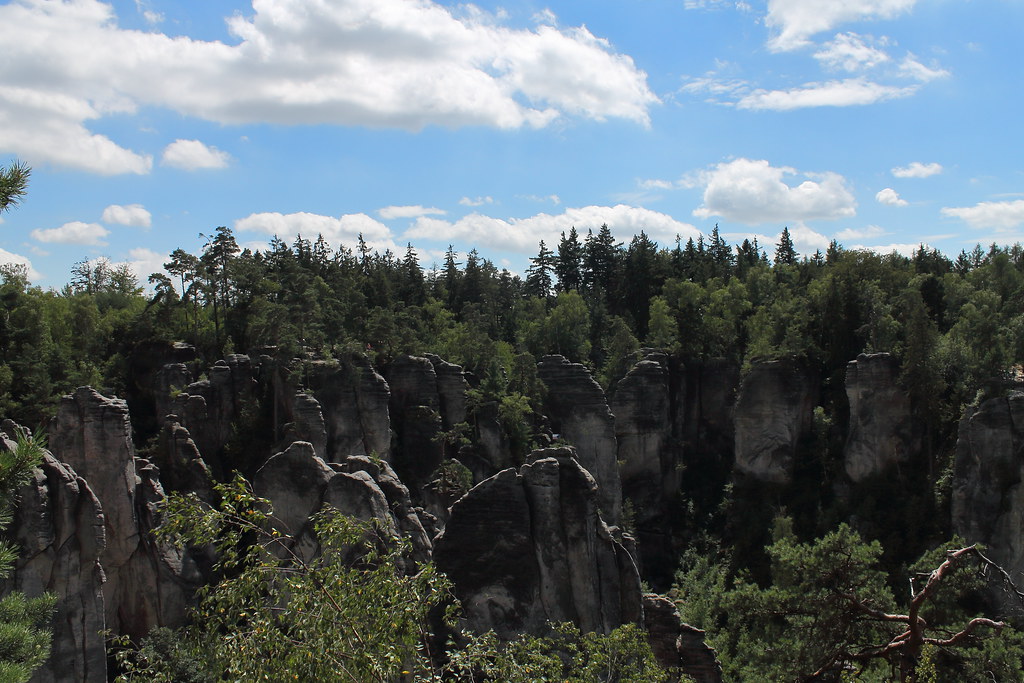
So here, I decided to let go of the vegetation, try to give a wider angle to the view. Also, notice the difference in aperture between the two pictures? Another thing I learned. The smaller aperture allows for sharper landscape pictures (in short. I won’t give you a lesson on aperture values and depth of field, I’m a padawan not a master, but look it up if you don’t know what I mean :p). To keep a blue sky, the towers ended up a bit dark for my taste. Guess a graduated filter would have come in handy at this point…
Donc là, j’ai laissé tombé la végétation, tenté d’élargir le cadre. Aussi, voyez la différence d’ouverture entre les deux photo? Un autre truc que j’ai appris. Une ouverture plus petite permet des paysages plus nets (je vous la fais court. On va pas faire une lesson sur le lien entre ouverture et profondeur de champ, chuis un padawan pas un maître, mais cherchez sur le net si vous ne voyez pas de quoi je parle :p). Pour garder le ciel bleu, les tours se sont retrouvées un peu trop sombres à mon goût. J’imagine qu’un filtre gradué aurait été pratique à ce niveau-là…
So, what do you think? Do you also sometimes revisit your old pictures? And/or retake pictures of the same place after some time, applying what you’ve learned since them and try to see your improvement? I think it’s an interesting and valuable exercise, isn’t it?
Alors, qu’en pensez-vous? Est-ce que vous aussi vous revisitez parfois vos vieilles photo? Et/ou reprenez des photos du même endroit après un certain temps, en tentant de mettre en pratique ce que vous avez appris depuis et de mesurer vos progrès? Je pense que c’est un exercice intéressant et très constructif, pas vous?



bravo, très bien joué, c’est clair que tes nouvelles photos sont bien meilleures !
Super exercice que de revenir au même endroit.
LikeLiked by 1 person
J’imagine que tu dois pouvoir faire pareil, en fait, non? Surtout quand tu organises des ateliers, des sorties, tu dois bien finir par reprendre les mêmes photos aux mêmes endroits 🙂
LikeLike
oui c’est sur, mais quand je suis avec des élèves en general je prends très peu de photos. Et si je suis tout seul j’essaye de découvrir de nouveau coins, il y en a tellement encore que je ne connas pas !
LikeLiked by 1 person
I have to confess, I am happy with the point and shoot level…and the occasional lucky shot! But it is interesting how much you can have to work with if you know what you’re doing when you push that button.
LikeLiked by 1 person
Yeah, it is also pretty satisfying when you “get it right” once you know how the little imp is painting inside the box 😀
LikeLike